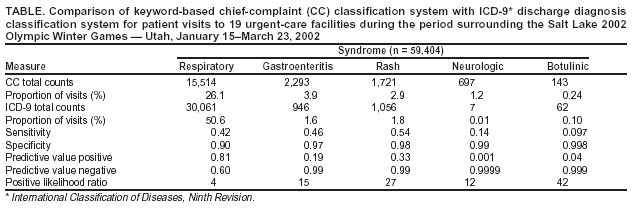 |
|
|
|
|
|
|
| ||||||||||
|
|
|
|
|
|
|
||||
| ||||||||||
|
|
|
|
|
Persons using assistive technology might not be able to fully access information in this file. For assistance, please send e-mail to: mmwrq@cdc.gov. Type 508 Accommodation and the title of the report in the subject line of e-mail. Syndromic Surveillance Using Chief Complaints from Urgent-Care Facilities During the Salt Lake 2002 Olympic Winter GamesMichael B. Mundorff,1 P.
Gesteland,1,2 M. Haddad,3,4 R.
Rolfs2,3,5
Corresponding author: Michael B. Mundorff, Intermountain Health Care, 36 South State St., Suite 2100, Salt Lake City, UT 84111. Telephone: 801-442-2896; Fax: 801-442-3486; E-mail: michael.mundorff@ihc.com. AbstractIntroduction: During the period surrounding the Salt Lake 2002 Olympic Winter Games, Utah's health departments conducted syndromic surveillance for potential early identification of natural or terrorist-introduced communicable disease outbreaks. Objectives: For minimal onsite intrusion and protection of patient confidentiality, electronic data from 19 urgent-care facilities were routed to public health authorities by using a computer program that mapped free-text chief complaints from patient registrations into selected syndromes. After the Games, the system's usefulness for determining five syndrome categories was evaluated. Methods: During January 15--March 23, 2002, syndromes were monitored as daily counts and proportions of total visits. Changes in occurrence over time were tracked by statistical process control charts. Findings were compared with other public health surveillance streams (e.g., influenza surveillance). Classification validity was examined by comparing five syndromes initially identified through chief-complaint data with a reference standard of International Classification of Diseases, Ninth Revision (ICD-9) discharge diagnoses. Sensitivity, specificity, predictive values, and likelihood ratios were measured. Results: Respiratory syndrome changes paralleled influenza seasonality. Occurrence of other syndromes remained relatively constant. The predictive value of classification by chief complaint varied substantially among syndromes (Table). Conclusions: Syndromic surveillance findings provided reassurance that no unexpected communicable disease outbreaks occurred. Validity measures for respiratory, gastrointestinal, and rash syndromes appear sufficiently promising to warrant additional investigation of this approach's value for detecting outbreaks manifesting as these syndromes. Effective syndrome classification by free-text chief complaint requires knowledge of disease presentations, local information systems, and linguistic conventions used by registration clerks. Table Return to top.
Disclaimer All MMWR HTML versions of articles are electronic conversions from ASCII text into HTML. This conversion may have resulted in character translation or format errors in the HTML version. Users should not rely on this HTML document, but are referred to the electronic PDF version and/or the original MMWR paper copy for the official text, figures, and tables. An original paper copy of this issue can be obtained from the Superintendent of Documents, U.S. Government Printing Office (GPO), Washington, DC 20402-9371; telephone: (202) 512-1800. Contact GPO for current prices. **Questions or messages regarding errors in formatting should be addressed to mmwrq@cdc.gov.Page converted: 9/14/2004 |
|||||||||
This page last reviewed 9/14/2004
|